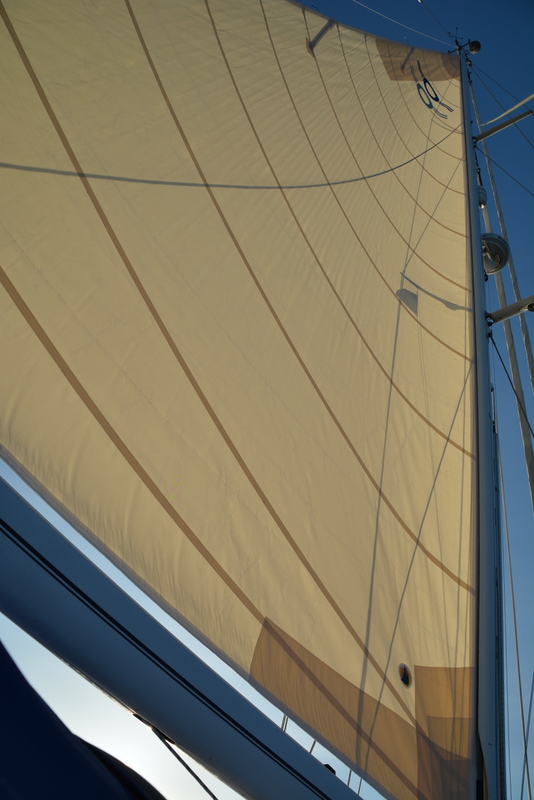
Vectran furling mainsail on Oyster 53
Things to Know Before You Buy an in-mast Furling Mainsail
Before we “roll” into a discussion of furling mains, here’s a quick recap of some terms we use:
Tack – Corner of the sail at forward end of boom
Clew – Corner of the sail at aft end of boom
Head – Top corner of sail
Leech – Side of sail between head and clew
Furling mains have much in common with headsails. In fact the construction process is quite similar, unless we’re installing batten pockets. A furling main without battens requires leech hollow. This means that the leech curves in slightly towards the center of the sail so it doesn’t flap. We can eliminate leech hollow partly or entirely with vertical battens. I theory it seems like the logical thing to do since we know that eliminating leech hollow will improve performance slightly. The key word here is slightly. Don’t expect a huge performance gain. You will be able to point a bit higher though. The downside is increased maintenance and increased potential of a jam.
Adding vertical battens adds some cost and complexity. If the battens are long enough to overlap, there is an increased possibility of the sail jamming. So we prefer to not have overlap between the top of one batten and the bottom of the next one up. There are some horizontal battens made of a material that allows them to curl up with the sail, however none have proven reliable for long term use unless they’re removed when the sail is not being used. Many things have been tried over the years like swing battens and even inflatable bladders.
We’re seeing sailmakers add roach to some furling mains, but none of them have been sufficiently reliable for us to offer. If you want to experiment with a furling main with roach, I’d recommend working with a local sailmaker who will recut the sail at no charge to eliminate that added roach if you’re struggling with it. One summer, Matt had to modify about half a dozen furling mains in that manner that were built by another sailmaker who was unable to or unwilling to address the issue. If you have a Hunter, some of the masts used have relatively small cavities that don’t work well with battens, so they can be more prone to jamming than other spars. Another issue with some B&R masts is that they can reach a point where they need to be pulled in order to be properly tuned.
One thing we always like to do is examine the spar manufacturer’s recommendations. In many cases, they specifically recommend against the use of battens, so be sure and check your documentation or ask your sailmaker if he or she has a copy. We don’t advise adding battens to a sail when the mast manufacturer has recommended against it and won’t guarantee functionality.
Corner patches reinforce sails in the areas where loads are being transmitted. With a conventional mainsail, we don’t have to worry about the thickness of the patches, however with a furling main, we are very concerned with the sail being able to fit well into the cavity. So we design the patches so they’re not too thick and we install them on the “outside” of the sail to facilitate furling.
The suncover on a furling mainsail is exposed to UV every day. On our premium cruising sails, we sew the suncover with GoreTex Tenara thread, which saves you from having to pull the sail off and restitch the suncover.
The last item I want to address are sail coating systems. The two most popular are Wet and Forget and Sailkote. Both are excellent for making your furling main easier to use and care for. Our production lofts have dedicated facilities to coat the sails before they ship. Here are the advantages offered with a coating:
Repels water
Decreases friction
Adds stain resistance
Coatings will keep the sail looking good and decrease the amount of effort required to furl and unfurl the sail. One of our clients with a lovely old Amel Maramu ketch with electric furling commented that he could hear the furling motors running more smoothly and it was obvious to him that the motors didn’t have to work as hard.
Questions? Please get in touch via the website or post a comment below.

Comments 2
Hello sirs
Can I use my original Mainsail on a behind the Mast furling system I have already sewn on the luff
tape but do not know what to do about Roach and the foot so that the sale will roll on the Furler properly
thank you
Author
Steven,
Thanks for your question. To begin with, behind the mast furling is not something I’d advise. The problem is it’s challenging to control luff sag resulting in poor sailing qualities, particularly pointing ability. There are a number of reasons you won’t want to attempt to use your existing mainsail.
1. Due to the luff sag, you would need to recut the luff curve of the main to make it more like a furling genoa.
2. You will need to have the leech modified to introduce some hollow. Not only can you not have roach but you need to add some hollow.
3. Since the main will be shifted quite a bit aft, the foot may be too long preventing you from being able to tension the foot.
4. Since the addition of a furler will reduce hoist considerably, your luff will be too long so you would need to shorten the luff.
You’d spend so much modifying the sail, you’d be better off just buying a new one. Don’t take this the wrong way, but I think you would be much happier if you sold the boat and bought a boat with an in-mast furling as opposed to retro-fitting a furler to the boat.